From cosmopolitan cities like Toronto and Vancouver to breathtaking wilderness in the Rockies, Canada offers world-class travel experiences-and navigating money in Canada is pleasantly straightforward. The Canadian Dollar (CAD) is the official currency, and cards are widely accepted even in small businesses and taxis. But don’t rely solely on plastic-some rural areas and festivals still prefer cash. ATMs are plentiful, but international fees vary by bank, and exchange kiosks at airports often offer poor rates. This guide explains how to get the best value when using or exchanging currency in Canada, helping you spend smart across provinces.
How to pay in Canada – cash or card?
Over 75% of transactions in Canada are done with credit or debit cards, making them the most popular ways to pay. People still use cash, but mostly for smaller purchases. About 20% of all transactions made by tourists at the point of sale are made with cash. Mobile wallets and digital payments are becoming increasingly popular, especially among younger people.
You can use cash for:
- Tips and gratuities (often preferred in cash for service workers)
- Street food (food trucks, small stands)
- Small purchases
- Local expenses at farmer’s markets or indie retailers
- Laundry services (especially coin laundromats)
- Nightlife / bars (some local bars prefer cash for cover or tips)
- Mobile SIM and phone top-up (in convenience stores)
You can use card for:
- Budget hotels
- Hostels
- 4 and 5 star hotels
- Local tour operators
- Large tour operators
- Shopping at street markets (many accept contactless)
- Shopping at malls and chains
- Entry fees to museums, historical sites, national parks
- Local buses (contactless/tap accepted in most cities)
- Local taxis / App-based taxis
- Local trains (VIA Rail, city metro and light rail)
- Airport transport (express trains, buses, taxis)
- Small eateries / restaurants
- Sit-down restaurants
- Upscale restaurants
- Online bookings for upscale hotels, flights, tours
- Spas
- Tailoring services
- Vehicle renting
- Emergency medical clinics / pharmacies
Canada is extremely card- and contactless-friendly, even in remote areas. Credit and debit cards are widely accepted everywhere, including transit and taxis. Tipping culture is strong-carry small bills for tips.
What’s the best currency to take to Canada?
The Canadian Dollar (CAD) is the country’s main currency. CAD is what is mainly accepted in Canada. There are $5, $10, $20, $50, and $100 bills.
Use of Foreign Currencies: Some border towns, popular tourist spots, and some large hotel chains may accept US Dollars, but most transactions are done in Canadian Dollars. It’s not common to accept Euros and Pounds.
So, Canadian Dollar is the best currency to take to Canada.
Where to get the local currency in Canada?
In Canada, you can get the local currency in 3 ways. These are:
ATMs, or
Currency exchange
Money transfer and local pick-up
Types of cards to swipe in Canada
Visa and Mastercard transactions are commonly accepted for swiping. You might also find some places that accept Amex and other cards, albeit less frequently.
Types of cards at ATMs in Canada
When withdrawing money in Canada, majority of the ATMs will accept Visa, Mastercard, Cirrus, and Plus and Maestro cards. Some of them accept UnionPay cards. Others such as Amex, Diners, Discover, JCB, Rupay are not usually accepted by many ATMs.
Should I exchange money before travelling to Canada?
It’s helpful to bring a small amount of Canadian Dollars (CAD) for immediate expenses like airport transport, snacks, or tips. However, exchange rates outside Canada are often less favorable, and availability may be limited in some countries.
ATMs are abundant throughout Canada-in airports, cities, and towns-and most accept international cards from Visa, Mastercard, Cirrus, Plus, and Maestro networks. It’s wise to check with your bank about international fees, withdrawal limits, and whether your card supports CAD transactions.
If exchanging cash, do so at Canadian banks or authorized currency exchange services in the city. Airport exchange counters are convenient but may offer worse rates and higher fees. USD is widely recognized and easily exchanged within Canada if needed.
Canada is largely cashless, and debit/credit cards are accepted almost everywhere-including taxis, restaurants, supermarkets, and even vending machines. That said, it’s still good to carry some CAD cash, especially if visiting rural areas or small vendors.
Where to withdraw money in Canada
The best ATMs for foreigners to use in Canada are those owned by popular banks such as:
- Scotiabank
- TD Bank
- Royal Bank of Canada (RBC)
- CIBC
- Desjardins
A group of banks around the world work together to make the Global ATM Alliance possible. Customers of this alliance can get cash from any partner bank in the world without having to pay an ATM fee. The Global ATM Alliance is made up of many banks from the US, UK, Europe, Australia, and Latin America. Bank of America, Barclays, Deutsche Bank, and others are among them. Canada’s Scotiabank is a part of this network.
For a detailed guide, read Cash and ATMs in Canada.
Discover fee-free and low-fee ATMs on the ATM Fee Saver mobile app for iOS and Android. This app provides ATM PINs and details of leading bank ATMs such as ATM fees and withdrawal limits for foreign cardholders at ATMs in Canada. Moreover, its simple fee calculator helps you determine exact withdrawal charges. You can also find cash tips and tricks on the app for 160+ countries including Canada.
Download now from the App Store or Play Store.
Where to exchange currency in Canada
In Canada, you can exchange currency at authorised currency exchanges, banks, airports, and hotels, the most popular being authorised currency exchanges.
Currency exchange in Canada is best handled at licensed exchange providers rather than banks, as they often offer better rates and lower fees. These offices are located in major cities, malls, tourist areas, and near border crossings.
- Notable currency exchanges are:
Calforex (locations in Toronto, Vancouver, Calgary, Montreal)
International Currency Exchange (ICE) – Available at major airports
VBCE (Vancouver Bullion & Currency Exchange) – Excellent rates in Vancouver
Knightsbridge FX – Online and phone-based service with competitive rates
Exchange kiosks in airports offer convenience but generally have worse rates.
- Banks Offering Currency Exchange:
RBC (Royal Bank of Canada)
TD Canada Trust
Scotiabank
CIBC
BMO (Bank of Montreal)
While these banks offer reliable currency exchange, they typically charge higher margins and may require advance notice for less common currencies.
💡 Tip: If using ATMs to withdraw CAD, use machines affiliated with your bank network to avoid unnecessary surcharges. Always decline dynamic currency conversion when offered.
Pro-tips:
Stay away from airport exchanges – Poor rates
Avoid the black market – Be wary of being conned.
Include fresh notes – If your notes are damaged or dirty, you can expect to pay more or less.
Is carrying money in Canada safe?
In general, it is safe to carry cash around with you when you travel in Canada. Here are some ways to make sure your cash is safe:
Some safety tips for carrying cash while travelling in Canada are:
Carry only the cash you need.
Do not keep all the cash in one pocket or wallet.
Put some cash in a safety belt or fanny pack.
Do not flash your cash.
When paying, do not remove or display your entire cash.
Keep wallets preferably in front pockets.
Cross-wear your purses if possible.
Hold your purses, wallets and bags close and tight on crowded streets and in public trains and buses.
When withdrawing cash, keep the cash low while you count it so people around don’t see it.
If you’re dining alone, don’t leave your wallet / bag unattented while you go to the restroom.
If sitting outdoors in a restaurant, don’t leave your wallets / bags on the table.
Is it better to use debit or credit cards or pay by cash in Canada
Use a card if it is fee-free i.e. your bank does not charge any fees to swipe the card, when the merchant / POS also does not impose any extra charge to use a card, you need to use the insurance of the card, don’t want to block cash of large purchases and card’s swipe fees are lower than withdrawal fees.
Pay by cash by withdrawing cash from ATM or exchanging currency where – fees on ATM withdrawals are lesser than fees on swiping cards, you don’t want to leave any digital footprint of your expenses, it is convenient and easier to conduct transactions.









